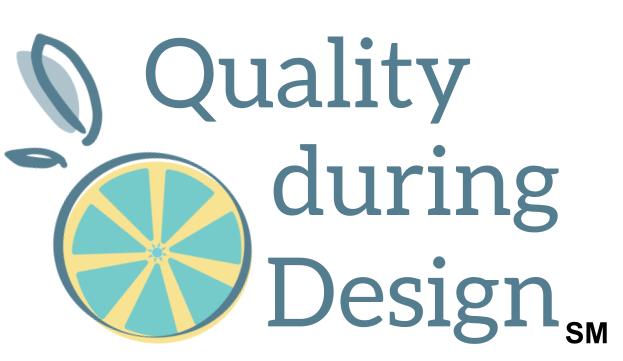We're getting into tolerancing our specifications today. Specifically, we're adding tolerance windows to the dimensions of our product, setting specs for our quality characteristics (those are the features that we want to measure). There's a lot to consider. There's a tolerance stack up analysis we should do with interfacing parts. Maybe there's a purchased component with a wide spec that we need to be able to mate with one of our in-house design products. There is manufacturing capability, too. A plastic injection molded part with a tolerance of plus or minus three thousands of an inch is going to be harder and more costly to maintain than one with a larger, more reasonable tolerance. If we set tight tolerances, it could be costly to make with a lot of rejects and rework in the future. If we're too sloppy with their tolerances, then it can affect the functionality of our product, leading to unhappy customers and also possible rework and scrap. There's economics involved in setting up tolerances. Is there another technique that we can use to set tolerances? I want to talk today about the Taguchi Loss Function. More about this after the brief introduction.
Hello and welcome to quality during design the place to use quality thinking to create products others love, for less. My name is Dianna. I'm a senior level quality professional and engineer with over 20 years of experience in manufacturing and design. Listen in and then join the conversation at QualityDuringDesign.com.
Typical specs have a nominal, or a target, value with a tolerance window. When manufacturing product and inspecting its quality characteristics, if the part is measured within the spec window then it's considered acceptable and is released. It moves along down the production stream or out the door. For example, the target diameter of our round part is 1-1/8th of an inch. The tolerance is plus or minus an eighth of an inch. If the part measures anywhere between one inch to 1-1/4 inches in diameter, it's within the spec window and gets released. This can lead to trouble down the production line or in the hands of the customer, especially so if we have a complex design with a lot of intersecting parts. When we get a stack up of parts that are supposed to work together and they're manufactured at the edges of our tolerance windows, there is a possibility that they won't work together as they should. I've seen it and I've read of other cases too.
There's a different philosophy about tolerances. Genichi Taguchi was a Japanese engineer whose work started in the 1950s. His philosophy was that quality deteriorates as our quality characteristic moves away from its target. It's different than 'anything produced within the tolerance is high quality'. It's that 'the target value is high quality, and it gets worse the farther we get from the target.' So, Taguchi's measure of quality was the variation from the target value of a spec.
In the introduction of this episode, we talked about how setting specs involved a lot of economics with scrap, rework, and failures adding to costs and relating to tolerances. Taguchi related his measure of quality (or variation from the target spec) with economics. It's called the Taguchi Loss Function. It's used to calculate the cost (in money) of a certain deviation from a target value. It assumes that the farther the quality characteristic is from our target value, the more costly it is. There is a version of the Taguchi Loss Function for two-sided tolerances, and there are different versions of this function for one-sided tolerances. I'll post all the equations on the podcast blog and I'll also include a link from Geogebra to an interactive plot of the Taguchi Loss Function.
The Taguchi Loss Function can be used to compare manufacturing production lines. If one has to be shut down, which one should it be? Maybe it's not the line that produces the most product that's within spec. Maybe it's the line that produces product that is closest to the target spec most consistently. We may make a different decision based on the economics of the situation. It can also be used to set tolerances for quality characteristics. To do this we use it in that economics-evaluation way, where we calculate the loss with each variance from the target. We'll have a break even point where we'll see that a value of our quality characteristic is associated with the cost.
Let's talk through an example of how we can use the Taguchi loss function to set some tolerances. We have a product with a quality characteristic that we can adjust in the factory during manufacturing. We can also make that adjustment as a repair service. It costs us $3 to make that factory adjustment to our device before it leaves our shipping dock. However, if a customer will return a device under warranty, that could cost us at least $15 to adjust our product considering shipping and handling and distributor repair costs. There's also the hidden cost of damage to our reputation in the eyes of the customer, so the actual cost is higher. If we know, or can estimate, at what level of our quality characteristic the customer is likely to notice and return the product to get it fixed, then we can calculate the Taguchi Loss Function constant in dollars. Given that, we can then calculate the loss function at different values of our quality characteristic. We can end up with a two column matrix with our target quality characteristic in one column and the loss in dollars in the other. At the target value of our quality characteristic, the loss function is zero. Then it steadily increases the farther we get from that target. We can find out where the loss function equals our internal repair costs of $3. We can choose to set our tolerance window to match that value so that we adjust that quality characteristic in-house and avoid the repair and warranty costs. We can even take it a step further: we can multiply our loss function by a weight to get a weighted loss. That way it could be the probability of a process producing a part within that spec.
You can see how the Taguchi Loss Function can be used to help drive continuous improvement after initial specs are set because will have real life data and experiences to use in its calculation. But if we're designing something similar to a product that's already in the market, then we may have good estimates for our new design. That's a case where we can easily use the loss function to determine tolerances of our new product in its earlier design phases. Or we can estimate its inputs as a way to figure out a spec instead of just relying on our engineering gut or compensating from not really knowing by making really tight tolerances.
What's today's insight to action? Check out this podcast blog for the formulas and an interactive plot of the Taguchi loss function. Understand that we should be communicating targets or nominal dimensions for our quality characteristics when possible. Keep design for manufacturability in mind and realize that there's increasing costs to product that drifts from the target, even if it's within our tolerance window. And we can keep the Taguchi loss function in mind as a tool to figure out what that design spec should be. Linking our tolerances to economics is viable and a realistic thing to do.
Please visit this podcast blog and others at qualityduringdesign.com. Subscribe to the weekly newsletter to keep in touch. If you like this podcast or have a suggestion for an upcoming episode, let me know. You can find me at qualityduringdesign.com, on LinkedIn, or you could leave me a voicemail at 484-341-0238. This has been a production of Denney Enterprises. Thanks for listening!


